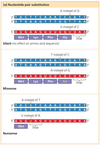Lecture Two - Mutations and gene regulation Flashcards
What are the different kinds of mutations?
Silent mutation: A change in the base sequence that causes the same amino acid to be coded for. Therefore no change in the overall DNA sequence.
Missense mutation: A change in the base sequence which causes a different amino acid to be coded for. This can cause the wrong, or a faulty DNA sequence. May no be very harmful, depending on where the mutation occured on the DNA sequence.
Nonsense mutation: A change in the base sequence which codes for a STOP codon to be coded for. This can be very harmful if the mutation occurs early on in the DNA sequence, but less harmful if it occurs later in the DNA sequence.
Frameshift mutation: A frame shift mutation occurs when a nucleotide is added or deleted (not including a multiple of three nucleotides) causing the ‘reading frame’ to be shifted to the right or left during the translation phase of protein synthesis.

What can cause mutations?
Oxidative damage from normal cellular metabolism.
Errors in the process of DNA replication or DNA recombination.
Frequency is about one nucleotide in every 10^10 in eukaryotes for during DNA replication.
That about one error every three DNA recombinations.
Chemicals e.g. tobacco.
Radiation (UV, gamma and x-rays).
How does E. coli regulate tryptophan?
Negitive regulation.

How does E. coli regulate lactose?
Negitive regulation.

How does E. coli regulate the use of lactose as an energy source, over glucose?

How are genes regulated and expressed in eukaryotes (general overview)?

How does chromatin control aspects of gene expression?

How is transcription initiated in eukaryotes?



